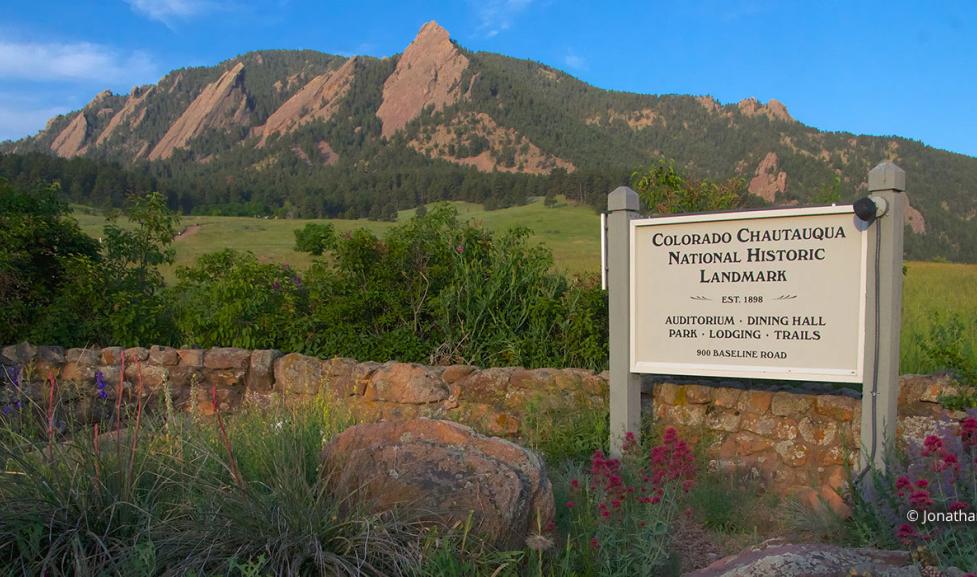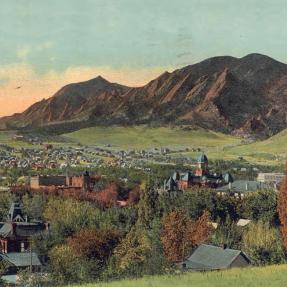The Colorado Chautauqua Association (CCA) and the City of Boulder are developing a comprehensive Sustainability and Resilience Strategy with the key goal of better aligning priorities to plan for long-term sustainability, resilience and preservation at Chautauqua. The CCA has committed to becoming a leader in environmentally sustainable practices. The Chautauqua Sustainability & Resilience Strategy will serve as a model for sustainable historic preservation around the country.
Latest News
Developing Options for a Sustainable, Resilient and Equitable Chautauqua
At its last meeting, the Chautauqua Sustainability and Resilience Strategy Steering Committee identified study groups to review and further expand options in five areas, including:
- Renewable Energy
- Fire and Heat
- Water and Drainage
- Vegetation
- Resiliency District
Composed of subject matter specialists from the Colorado Chautauqua Association and the City of Boulder, the study groups will take an in-depth look at options in these areas, taking into account feedback gathered from the community. They will examine background material from a wide variety of sources, engage subject matter experts, propose additional options and apply a set of criteria to rate the options. Each of the study groups will summarize its recommendations, ratings and methodology to present to the Steering Committee.
Community Input
Thank you to the over 230 people who completed our first questionnaire. Your input will be used to help inform the options we explore to achieve sustainability, resilience and equity at Chautauqua.
Results of the first questionnaire reveal that:
- Over 75% of respondents consider that Chautauqua will be directly impacted by climate change
- A majority of respondents consider that the effects of heat, drought and fire constitutes the largest vulnerability at Chautauqua
- Increasing visitation is an important vulnerability
- The threats identified in the Vulnerabilities Assessment may imperil the historic, cultural and natural character of Chautauqua
Vulnerabilities Assessment
Recently, a Vulnerabilities Assessment was conducted to identify the projected impacts of climate change at the Chautauqua National Historic Landmark District (NHL) and is the first step in developing mitigation and adaptation plans in a comprehensive Sustainability and Resilience Strategy for this cherished place.
Background
Chautauqua was established in 1898 and today recognized as one of the most historically and culturally significant places in Colorado. The Chautauqua NHL comprises 40 acres of land owned by the City of Boulder, 26 of which are leased to the Colorado Chautauqua Association (CCA). This collection of irreplaceable historic buildings, structures, objects and cultural landscapes is situated at the urban/wildland interface, presenting a unique set of vulnerabilities.
Vulnerabilities
The Vulnerabilities Assessment is organized according to seven systems (built, cultural, ecological, economic, neighborhood, infrastructure, transportation) and places identified vulnerabilities into the context of systems they affect.
- Identified vulnerabilities include water & drainage, heat, fire, aging buildings & infrastructure, increased visitation and adjacency to open space land.
- Identified vulnerabilities are ranked (high, medium, low) with aging infrastructure, drainage, fire and increased visitation all categorized as high and requiring immediate attention.
- Preservation of the unique character of the Chautauqua NHL will present challenges and require creative thinking in developing options for mitigation and adaptation to identified vulnerabilities.
The results of the Vulnerability Assessment will help inform the second step of the project in developing options to mitigate risk and achieve long term sustainability and resilience at the Chautauqua NHL.
Project Timeline
Step One: What are the vulnerabilities?
What are the vulnerabilities at Chautauqua? This phase of work is complete. Read the Vulnerabilities Assessment (PDF) to learn about climate change risks specific to Chautauqua and why it’s important to address them.
Step Two: What are our options?
What are the options to achieving sustainability, resilience and equity at the Chautauqua Historic District? It’s a big question! We are now collecting input from community members to create options. Complete the questionnaire by visiting our Be Heard Boulder website.
Step Three: How do we get there?
After identifying what are the best steps to make Chautauqua sustainable and resilient into the future, the Chautauqua Sustainability and Resilience Steering Committee will develop recommendations. These will be shared with the community and Boulder’s City Council.
Step Four: Recommendations
What happens when the S&R Strategy is complete? We’ll have a community-wide discussion of how the recommendations can be implemented in the context of Boulder’s Climate Mobilization Action Plan. We anticipate this will occur in the fall of 2020. Phase Two will include the implementation of the strategy recommendations over the following 2-5 years.

